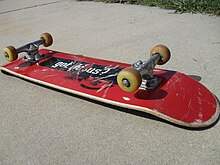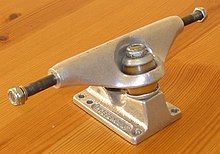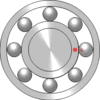Skateboard: Difference between revisions
ClueBot NG (talk | contribs) m Reverting possible vandalism by 124.9.8.66 to version by Dr.K.. False positive? Report it. Thanks, ClueBot NG. (793914) (Bot) |
No edit summary |
||
| Line 4: | Line 4: | ||
[[File:Skateboarder in the air.jpg|right|thumb|Skateboarder in the air]] |
[[File:Skateboarder in the air.jpg|right|thumb|Skateboarder in the air]] |
||
A '''skateboard''' is typically a specially designed [[plywood]] board combined with a polyurethane coating used for making smoother slides and stronger durability, used primarily for the activity of [[skateboarding]]. The first skateboards to reach public notice came out of the surfing craze of the early 1960s, developed to help surfers practice when waves were unfavorable. The first prototypes were simple wooden boards with roller-skate wheels attached, and the practice was sometimes referred to as "sidewalk surfing." The surfing group [[Jan and Dean]] even had a minor hit called "Sidewalk Surfing" in 1964. By the mid-1980s skateboards were mass produced and sold throughout the United States. |
A '''skateboard''' is a typically a specially designed [[plywood]] board combined with a polyurethane coating used for making smoother slides and stronger durability, used primarily for the activity of [[skateboarding]]. The first skateboards to reach public notice came out of the surfing craze of the early 1960s, developed to help surfers practice when waves were unfavorable. The first prototypes were simple wooden boards with roller-skate wheels attached, and the practice was sometimes referred to as "sidewalk surfing." The surfing group [[Jan and Dean]] even had a minor hit called "Sidewalk Surfing" in 1964. By the mid-1980s skateboards were mass produced and sold throughout the United States. |
||
A skateboard is propelled by pushing with one foot while the other remains on the board, or by [[Pump (skateboarding)|pumping]] one's legs in structures such as a pool or [[half pipe]]. A skateboard can also be used by simply standing on the deck while on a downward slope and allowing gravity to propel the board and rider. If the rider positions their right foot forward, he/she is said to ride "[[Footedness#Regular and Goofy|goofy]]"; if the rider positions their left foot forward, he/she is said to ride "[[Footedness#Regular and Goofy|regular]]." If the rider is normally regular but chooses to ride goofy, he/she is said to be riding "[[Footedness#Other varieties in footedness|switch]]," and vice versa. A skater is typically more comfortable pedaling with their back foot; choosing to pedal with the front foot is commonly referred to as riding "mongo." |
A skateboard is propelled by pushing with one foot while the other remains on the board, or by [[Pump (skateboarding)|pumping]] one's legs in structures such as a pool or [[half pipe]]. A skateboard can also be used by simply standing on the deck while on a downward slope and allowing gravity to propel the board and rider. If the rider positions their right foot forward, he/she is said to ride "[[Footedness#Regular and Goofy|goofy]]"; if the rider positions their left foot forward, he/she is said to ride "[[Footedness#Regular and Goofy|regular]]." If the rider is normally regular but chooses to ride goofy, he/she is said to be riding "[[Footedness#Other varieties in footedness|switch]]," and vice versa. A skater is typically more comfortable pedaling with their back foot; choosing to pedal with the front foot is commonly referred to as riding "mongo." |
||
Revision as of 23:44, 4 January 2012
This article needs additional citations for verification. (January 2010) |


A skateboard is a typically a specially designed plywood board combined with a polyurethane coating used for making smoother slides and stronger durability, used primarily for the activity of skateboarding. The first skateboards to reach public notice came out of the surfing craze of the early 1960s, developed to help surfers practice when waves were unfavorable. The first prototypes were simple wooden boards with roller-skate wheels attached, and the practice was sometimes referred to as "sidewalk surfing." The surfing group Jan and Dean even had a minor hit called "Sidewalk Surfing" in 1964. By the mid-1980s skateboards were mass produced and sold throughout the United States.
A skateboard is propelled by pushing with one foot while the other remains on the board, or by pumping one's legs in structures such as a pool or half pipe. A skateboard can also be used by simply standing on the deck while on a downward slope and allowing gravity to propel the board and rider. If the rider positions their right foot forward, he/she is said to ride "goofy"; if the rider positions their left foot forward, he/she is said to ride "regular." If the rider is normally regular but chooses to ride goofy, he/she is said to be riding "switch," and vice versa. A skater is typically more comfortable pedaling with their back foot; choosing to pedal with the front foot is commonly referred to as riding "mongo."
Recently, electric skateboards have also appeared. These no longer require the propelling of the skateboard by means of the feet; rather an electric motor propels the board, fed by an electric battery.
There is no governing body that declares any regulations on what constitutes a skateboard or the parts from which it is assembled. Historically, the skateboard has conformed both to contemporary trends and to the ever evolving array of stunts performed by riders/users, who require a certain functionality from the board. Of course, the board shape depends largely upon its desired function. Longboards are a type of skateboard with a longer wheelbase and larger, softer wheels.
Parts
Descriptions of the following skateboard parts are the ones most prevalent in popular, modern forms of skateboarding. Many parts exist with exotic or alternative constructions and designs that fall outside of much of the descriptions listed. The usual parts to design a complete skateboard are the deck, trucks, wheels, bearings, hardware, bushings and griptape.
Deck

Most decks are constructed with a six to seven-ply cross-laminated maple wood. Some of them have special materials that help to keep the deck from breaking: such as fiberglass, bamboo, resin, Kevlar, carbon fiber, aluminum, and plastic. Some decks made from maple ply are dyed to create various different coloured ply. Modern decks vary in size, but most are 7 to 10.5 inches (17.78 to 26.67 centimeters) wide. Wider decks can be used for greater stability when transition or ramp skating. Skateboard decks are usually between 28 and 33 inches (71.12 and 83.82 centimetres) long. The underside of the deck can be printed with a design by the manufacturer, blank, or decorated by any other means.
The longboard, a common variant of the skateboard, has a longer deck. This is mostly ridden down hills or by the beach to represent the riding of a wave in the ocean on a surfboard. This was created by two surfers; Ben Whatson and Jonny Drapper. One of the first deck companies was called "Drapped" taken from Jonny's second name. "Old school" boards (those made in the 1970s–80s or modern boards that mimic their shape) are generally wider and often have only one kicktail. Variants of the 1970s often have little or no concavity, whereas 1980s models have deeper concavities and steeper kicktails.[citation needed]
Grip tape, when applied to the top surface of a skateboard, gives a skater's feet grip on the deck. It is most often black but can come in a variety of colors including clear, allowing the top of the deck to be decorated. It has an adhesive back and a sandpaper-like top.
Trucks

Attached to the deck are two metal (usually aluminum alloy) trucks, which connect to the wheels and deck. The trucks are further composed of two parts. The top part of the truck is screwed to the deck and is called the baseplate, and beneath it is the hanger. The axle runs through the hanger. Between the baseplate and the hanger are bushings, also rubbers or grommets, that provide the cushion mechanism for turning the skateboard. The bushings cushion the truck when it turns. The stiffer the bushings, the more resistant the skateboard is to turning. The softer the bushings, the easier it is to turn. A bolt called a kingpin holds these parts together and fits inside the bushings. Thus by tightening or loosening the kingpin nut, the trucks can be adjusted loosely for better turning and tighter for more stability. Standard Kingpin nut size is 3/8" - 24tpi.
Skateboard trucks are manufactured in a number of different axle widths. In general an axle width should be chosen that is close to the width of the deck it will be used with.[1] For example, a 7.75" wide deck will usually be fitted with trucks that have axles between 7.5" wide and 8.0" wide. (Standard truck axel nut size is 5/16"-24tpi UNF, and the thinner "jam" style with an optional nylon lock.) Trucks that are too wide can make doing tricks difficult and can cause the wheels to get in the way when the skateboard is being ridden. Trucks that are too small can be hard to maintain stability and can cause wheel bite to occur when turning.
Longboard specific trucks are a more recent development. A longboard truck has the king pin laid at a more obtuse angle (usually between 38 and 50 degrees[2]) to the deck, this gives a lesser degree of turning for the same tilt of the deck. This allows riders to go much faster while still maintaining stability and control.
Giant strides have been made in the truck industry over the years. In late 2007, Gullwing Truck Company manufactured a truck named "Sidewinder" that can pivot on two different angles, thus greatly decreasing the turning radius of the board, resulting in a greater feel between the rider and the sidewalk.
Wheels
The wheels of a skateboard, usually made of polyurethane, come in many different sizes and shapes to suit different types of skating. Larger sizes like 54–85 mm roll faster, and also move more easily over cracks in pavement. Smaller sizes like 48–54 mm keep the board closer to the ground, require less force to accelerate and produce a lower center of gravity, but also make for a slower top speed. Wheels also are available in a variety of hardnesses usually measured on the Shore durometer "A" scale. Wheels range from the very soft (about Shore A 75) to the very hard (about Shore A 101). As the A scale stops at 100, any wheels labeled 101A or higher are harder, but do not use the appropriate durometer scale. Some wheel manufacturers now use the "B" or "D" scales, which have a larger and more accurate range of hardness. Modern street skaters prefer smaller wheels (usually 51–54 mm), as small wheels with lighter trucks can make tricks like kickflips and other flip tricks easier by keeping the center of gravity of the skateboard closer to the deck, thus making the deck easier to spin. Street wheels are often quite hard as this allows the wheels to slide easier on waxed surfaces for bluntslides and nose/tailslides. Vertical ramp or "vert" skating requires larger wheels (usually 55–65 mm), as it involves higher speeds. Vert wheels are also usually softer, allowing them to maintain high speed on ramps without sliding. Slalom skating requires even larger wheels (60–75 mm) to sustain the highest speeds possible. They also need to be soft and have better grip to make the tight and frequent turns in slalom racing. Even larger wheels are used in longboarding and downhill skateboarding. Sizes range from 65 mm to 100 mm. These extreme sizes of wheels almost always have cores of hard plastic that can be made thinner and lighter than a solid polyurethane wheel. They are often used by skateboard videographers as well, as the large soft wheels allow for smooth and easy movement over any terrain.

Grip tape
Grip tape is a sheet paper or fabric with adhesive on one side and a surface similar to fine sand paper on the other. Grip tape is applied to the top surface of a board to allow the rider's feet to grip the surface and help the skater stay on the board while doing tricks. Grip tape is usually black, but is also available in various colors, camo, and even clear. Often times they have designs die-cut to show the color of the board, or to show off the board's company logo.
Bearings
Each skateboard wheel is mounted on its axle via two bearings. With few exceptions, the bearings are the industrial standard "608" size, with a bore of 8 mm, an outer diameter of 22 mm, and a width of 7 mm. These are usually made of steel, though silicon nitride, a high-tech ceramic, is sometimes used. Many skateboard bearings are graded according to the ABEC scale. The scale starts with ABEC1 as the lowest, 3, 5, 7, 9. It is a common misconception that the higher ABECs are better for skateboarding, as the ABEC rating only measures tolerances, which do not necessarily apply to skateboards. The ABEC rating does not determine how fast or how durable a bearing used for skateboarding will be.[3] In particular, the ABEC rating says nothing about how well a bearing handles axial (side-to-side) loads, which are severe in most skateboard applications. Many companies do not show the ABEC rating, such as Bones Bearings, which makes bearings specifically for skateboarding, often marketed as "Skate Rated". Each bearing usually contains 7 steel or ceramic ball bearings, although other configurations are used as well.
Hardware
Mounting hardware is a set of eight 10-32 UNC bolts, usually an Allen or Phillips head, and matching nylon locknuts. They are used to attach the trucks to the board. Some sets have one different colored bolt to show which side is the nose of the skateboard.
Optional components
Risers/wedges
Risers increase the space between the truck and the deck. This allows the truck to twist further without causing wheel bite (when the wheel touches the deck and stops rotating). Wedges can be used to change the turning characteristics of a truck.[4]
Rails/ribs
Narrow strips of plastic or metal that are attached under the deck lengthwise along the edges. They are used for additional grip for grabs, and to enhance sliding while protecting the deck's graphics at the same time. Although rarely used anymore, they are useful for experienced skaters that are capable of grabs.
Sliptape
Sliptape is a clear piece of self adhesive plastic that sticks to the underside of a deck. It helps protect the board's graphics and allows the board to slide easier. Another name for this is everslick.
Lapper
A lapper is a plastic cover that is fastened to the rear truck and serves to protect the kingpin when grinding. It also prevents hang-ups by providing a smoother transition for the truck when it hits an obstacle or a metal pipe or round bar.
Nose guard
A plastic bumper used to protect the front of a skateboard. Used in old school boards.
Tail guard
Is a plastic cover that protects the tail end of the skateboard from scratching
Tail Devil
Sparking device placed on the tail or nose of the skateboard.
Copers
Plastic half tubing that protected the axles of the trucks. In the 1980-85 period, stolen shopping cart handles were cut by some to fit as a makeshift coper.[citation needed]
See also
References
- ^ Has a guide to choosing the right size trucks for a skateboard deck http://skate-parts.com/blog/choosing-right-size-trucks-your-skateboard-deck
- ^ Contains a list of dimensions for popular longboard truck manufacturer http://www.randal.com/guides_faq.html
- ^ http://lushlongboards.com/workshop/abec-ratings-explained-c-199_200.html
- ^ A guide describing turning characteristics of different Riser/Wedge types http://www.randal.com/guides_faq.html
